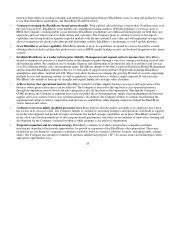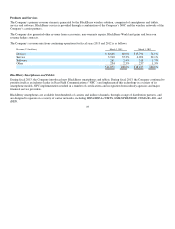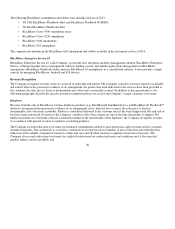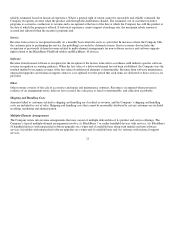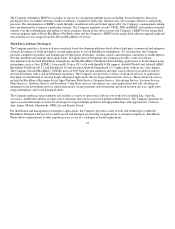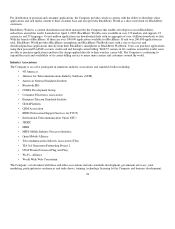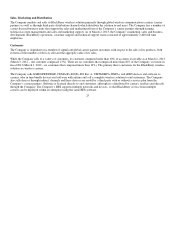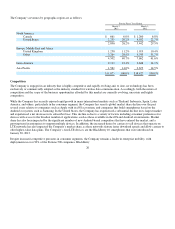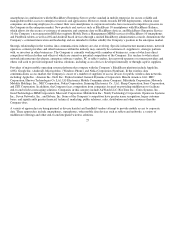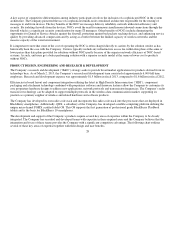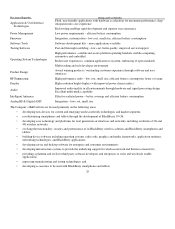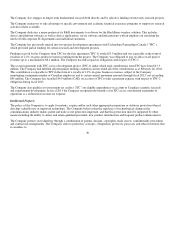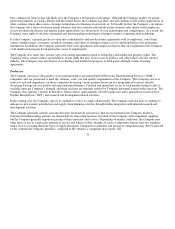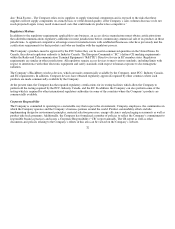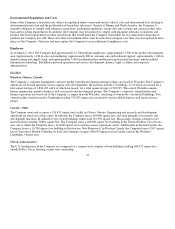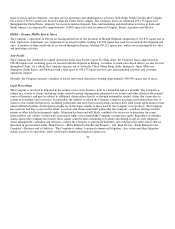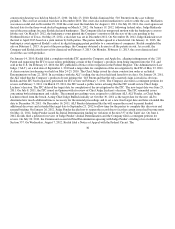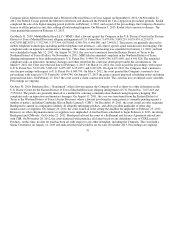Blackberry 2013 Annual Report Download - page 35
Download and view the complete annual report
Please find page 35 of the 2013 Blackberry annual report below. You can navigate through the pages in the report by either clicking on the pages listed below, or by using the keyword search tool below to find specific information within the annual report.
A key aspect of competitive differentiation among industry participants involves the inclusion of a sophisticated NOC in the system
architecture. The Company pioneered the use of a sophisticated multi-node centralized architecture responsible for the routing of
messages to and from devices. The key benefits of the NOC are message delivery reliability, network utilization efficiency and
security. By isolating firewalls from the devices, NOCs avoid the need for numerous simultaneous inbound connections through the
firewall which is a significant security consideration for many IT managers. Other benefits of NOCs include eliminating the
opportunity for Denial of Service Attacks against the firewall, protecting against bad packets reaching devices, and enhancing service
quality by providing advanced compression and by acting as a buffer between the limited capacity of wireless networks and the
massive capacity of the wired environment.
It is important to note that some of the cost of operating the NOC is often charged directly to carriers by the solution vendor as has
historically been the case with the Company. Carriers typically include any infrastructure access fee within data plans at the same or
lower prices than data plans provided for solutions without NOCs partly because of the superior network efficiency of NOC-based
systems. As such, end users get a better performing solution with a superior security model at the same or lower cost to products
without NOCs.
PRODUCT DESIGN, ENGINEERING AND RESEARCH & DEVELOPMENT
The Company’s research and development (“R&D”) strategy seeks to provide broad market applications for products derived from its
technology base. As of March 2, 2013, the Company’s research and development team consisted of approximately 6,000 full time
employees. Research and development expense was approximately $1.5 billion in fiscal 2013, compared to $1.6 billion in fiscal 2012.
Efficiencies in board layout and component integration utilizing the latest in High Density Interconnection (“HDI”), component
packaging and attachment technology combined with proprietary software and firmware features allow the Company to customize its
core proprietary hardware designs to address new applications, network protocols and transmission frequencies. The Company’s radio
transceiver technology can be adapted to support multiple protocols in the wireless data communications market, supporting its
position as a primary supplier of wireless and related hardware and software products.
The Company has developed its own radio code stack and incorporates this radio code stack into the processors that are deployed in
BlackBerry smartphones. Additionally, QNX, a subsidiary of the Company, has developed a mobile computing platform utilizing the
unique micro kernel POSIX certified tablet OS. This OS supports the first generation of professional grade BlackBerry PlayBook
tablets and is the basis for BlackBerry 10 smartphones.
The development and support of the Company’s products require several key areas of expertise within the Company to be closely
integrated. The Company has recruited and developed teams with expertise in these required areas and the Company believes that the
integration and focus of these teams provides the Company with a significant competitive advantage. The following chart outlines
several of these key areas of expertise together with their design and user benefits.
28


